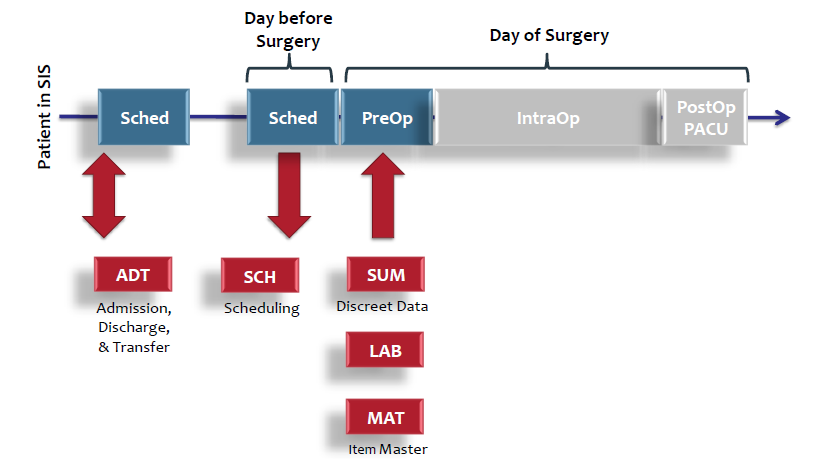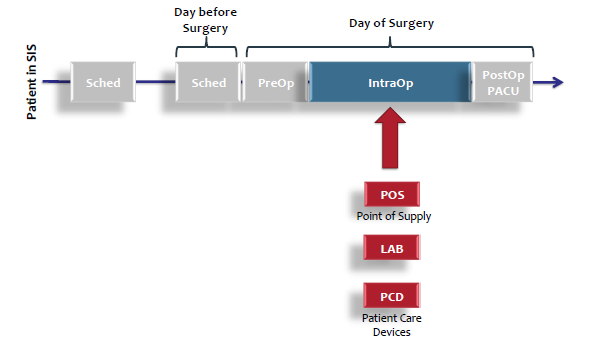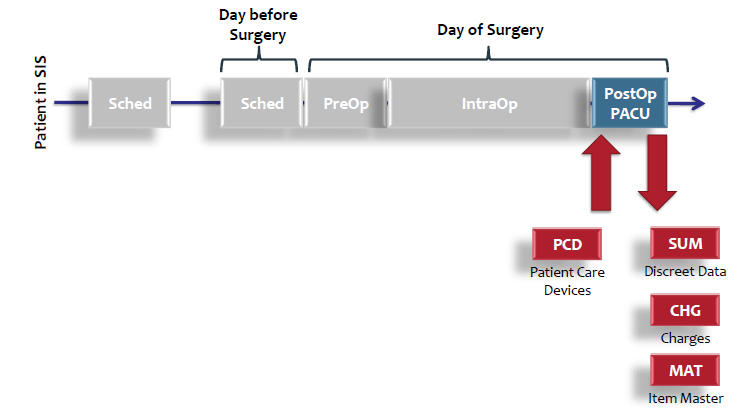HL7: one day in the operating room
This short article is written as a comment on my previous article , in particular in the part where BC Holmes reasons that “ one of the ways to quantify the complexity of HL7v3 in calculating the nesting levels of a typical message. It typically has 5-10 times more XML nodes than any other XML-based standards, such as Interactive Financial eXchange (IFX) or Amazon EC2 SOAP API. Someone may say that business processes in healthcare are much more complicated and semantically richer than in the financial field and, especially, in publishing. "
This is how to consider one typical process in health care, and we would like to make sure whether it is really more complicated and semantically richer than in financial or publishing activities. Benefit and visual material also turned up.
In this case, it will consider the work of the surgical department on the example of a set of informational messages to support one single surgical operation. The type of operation and its complexity is not reported, i.e. possible deviations in any direction of complexity.
Preoperative period
The preoperative period is the time required to prepare the patient for surgery. The duration of the preoperative period depends on the degree of urgency of the operation, the patient's condition, his age and the severity of the upcoming surgery. Information flows in the preoperative period are shown in the following diagram.
')

Conventionally, information flows can be divided into the following groups and the corresponding HL7v2 messages or templates of CDA documents (the types of HL7v2 messages and their brief decoding are given in brackets):
• Patient Registration (ADT),
• Waiting list control (SIU - Schedule change),
• Patient data (MDM - Medical Records Management, CCD, CDA Referral Summary),
• Results of lab analyzes (ORU - Survey Results, CDA for HITSP C37 Lab Report Document)
• Notifications (MFN - Changes in the Regulatory Reference File)
Operating period
The information flow for the operational period is presented in the following diagram.

The following HL7v2 messages are used to transmit information:
• Use of materials (DFT - Detailed financial transaction)
• Results of lab tests (ORU - Survey Results, CDA for HITSP C36 Lab Result Message)
• Data from medical devices (ORU - Survey results)
Postoperative period
The postoperative period is the time from the moment the patient is removed from the operating table to the healing of the wound and the disappearance of the disorders caused by the operating injury. Information flows in the preoperative period are shown in the following diagram.

The following HL7v2 messages are used to transmit information:
• Data from medical devices (ORU - Survey results)
• Patient data (MDM - Medical Records Management, CCD, CDA Referral Summary),
• Financial expenses (DFT - Detailed financial transaction),
• Use of materials (MFN - Changes in the regulatory reference file).
In addition to the above messages, the surgeon (more precisely, the IT department responsible for interfaces) has to think about the operation of the systems in accordance with the following standards:
• IHE ATNA - Audit Trail and Node Authentication
• HITSP T15 - Collect and Communicate Security Audit Trail Transaction
• HITSP T17 - Secured Communication Channel Transaction
• IHE XDS.b - Cross-Enterprise Document Sharing-b
• HITSP T13b - Manage Sharing of Documents
The above messages and other standards are described in the following IHE (Integrating the Healthcare Enterprise) profiles:
• Patient Care Device ;
• IT Infrastructure ;
• Patient Care Coordination .
Well, now, going back to the beginning of this article, I don’t understand why the IFX or Amazon EC2 SOAP API specialists cannot get along with HL7 together, everything seems to be quite simple there.
:)
I would also like to add a judgment about the HL7 FHIR. From all of the above, test FHIR servers are still fiddling with functionality equal to ADT and SIU messages. It is likely that there are more advanced implementations (at least one such I know), but their creators have so far not been in a hurry to speak openly and put the implementation features on the court.
This is how to consider one typical process in health care, and we would like to make sure whether it is really more complicated and semantically richer than in financial or publishing activities. Benefit and visual material also turned up.
In this case, it will consider the work of the surgical department on the example of a set of informational messages to support one single surgical operation. The type of operation and its complexity is not reported, i.e. possible deviations in any direction of complexity.
Preoperative period
The preoperative period is the time required to prepare the patient for surgery. The duration of the preoperative period depends on the degree of urgency of the operation, the patient's condition, his age and the severity of the upcoming surgery. Information flows in the preoperative period are shown in the following diagram.
')

Conventionally, information flows can be divided into the following groups and the corresponding HL7v2 messages or templates of CDA documents (the types of HL7v2 messages and their brief decoding are given in brackets):
• Patient Registration (ADT),
• Waiting list control (SIU - Schedule change),
• Patient data (MDM - Medical Records Management, CCD, CDA Referral Summary),
• Results of lab analyzes (ORU - Survey Results, CDA for HITSP C37 Lab Report Document)
• Notifications (MFN - Changes in the Regulatory Reference File)
Operating period
The information flow for the operational period is presented in the following diagram.

The following HL7v2 messages are used to transmit information:
• Use of materials (DFT - Detailed financial transaction)
• Results of lab tests (ORU - Survey Results, CDA for HITSP C36 Lab Result Message)
• Data from medical devices (ORU - Survey results)
Postoperative period
The postoperative period is the time from the moment the patient is removed from the operating table to the healing of the wound and the disappearance of the disorders caused by the operating injury. Information flows in the preoperative period are shown in the following diagram.

The following HL7v2 messages are used to transmit information:
• Data from medical devices (ORU - Survey results)
• Patient data (MDM - Medical Records Management, CCD, CDA Referral Summary),
• Financial expenses (DFT - Detailed financial transaction),
• Use of materials (MFN - Changes in the regulatory reference file).
In addition to the above messages, the surgeon (more precisely, the IT department responsible for interfaces) has to think about the operation of the systems in accordance with the following standards:
• IHE ATNA - Audit Trail and Node Authentication
• HITSP T15 - Collect and Communicate Security Audit Trail Transaction
• HITSP T17 - Secured Communication Channel Transaction
• IHE XDS.b - Cross-Enterprise Document Sharing-b
• HITSP T13b - Manage Sharing of Documents
The above messages and other standards are described in the following IHE (Integrating the Healthcare Enterprise) profiles:
• Patient Care Device ;
• IT Infrastructure ;
• Patient Care Coordination .
Well, now, going back to the beginning of this article, I don’t understand why the IFX or Amazon EC2 SOAP API specialists cannot get along with HL7 together, everything seems to be quite simple there.
:)
I would also like to add a judgment about the HL7 FHIR. From all of the above, test FHIR servers are still fiddling with functionality equal to ADT and SIU messages. It is likely that there are more advanced implementations (at least one such I know), but their creators have so far not been in a hurry to speak openly and put the implementation features on the court.
Source: https://habr.com/ru/post/259315/
All Articles